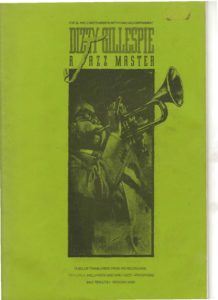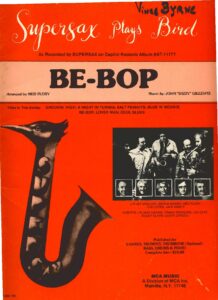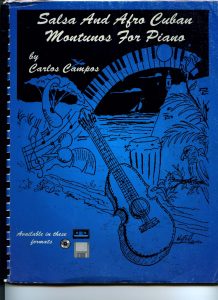Dizzy Gillespie – A Jazz Master Solo Transcriptions Trumpet
Come join us now, and enjoy playing your beloved music and browse through great scores of every level and styles!
Can’t find the songbook you’re looking for? Please, email us at: sheetmusiclibrarypdf@gmail.com We’d like to help you!
Table of Contents

Best Sheet Music download from our Library.

Please, subscribe to our Library.
If you are already a subscriber, please, check our NEW SCORES’ page every month for new sheet music. THANK YOU!

Browse in the Library:
Or browse in the categories menus & download the Library Catalog PDF:
Dizzy Gillespie: The Architect of Bebop
John Birks “Dizzy” Gillespie (October 21, 1917 – January 6, 1993) was an American jazz trumpeter, bandleader, composer, and singer. He is universally acclaimed as one of the most important and influential figures in the history of jazz. Alongside saxophonist Charlie Parker, he is credited as a co-founder of the bebop movement in the 1940s, which revolutionized jazz by shifting it from popular, danceable swing music to a more complex, virtuosic art form for listening.
He was famous not only for his musical genius but also for his charismatic stage presence, beret, horn-rimmed glasses, and his uniquely puffed-out cheeks while playing, but most of all, for his bent trumpet bell, which became his visual trademark.
Key Contributions and Legacy
1. Co-Creator of Bebop
After cutting his teeth in big swing bands (like those of Cab Calloway and Billy Eckstine), Gillespie, along with Parker, pianist Thelonious Monk, and others, began experimenting with a new style of jazz.
- Complex Harmony: Bebop used more complex chords and rapid chord changes than swing.
- Melodic Innovation: The melodies were faster, more erratic, and filled with unexpected twists, requiring incredible technical skill.
- Rhythmic Shift: It shifted the rhythmic emphasis, making the rhythm section (drums, bass, piano) more interactive and less of a steady time-keeping force.
2. Virtuoso Trumpeter
Gillespie was renowned for his phenomenal technical ability on the trumpet. He possessed:
- Blistering Speed: He could play incredibly fast, complex lines with perfect clarity.
- Harmonic Creativity: His solos were harmonically sophisticated, often venturing into new tonal territories.
- Incredible Range: He had masterful control over the instrument’s upper register.
3. Pioneering Composer
He wrote some of the most enduring standards in the jazz repertoire, including:
- “A Night in Tunisia”: Perhaps his most famous composition, known for its iconic bass line and Latin feel.
- “Groovin’ High”
- “Salt Peanuts” (known for its catchy, scat-like riff)
- “Woody ‘n’ You”
- “Manteca” (a foundational song in the Afro-Cuban jazz movement)

4. Father of Afro-Cuban Jazz
Gillespie had a profound interest in Latin and Cuban rhythms. In the late 1940s, he fused bebop with Cuban music, creating a new genre: Afro-Cuban jazz.
- He collaborated with Cuban conga player Chano Pozo, and together they created groundbreaking works like “Manteca.”
- This fusion brought instruments like the conga and bongos into the modern jazz ensemble, expanding the genre’s sonic palette.
5. Mentor and Teacher
Unlike the tragic figure of Charlie Parker, Gillespie was a charismatic and generous ambassador for jazz. He nurtured young talent and was always willing to teach and explain his innovative ideas to the next generation of musicians.
6. The Bent Trumpet
The story goes that the bell of his trumpet was accidentally bent upward in 1953. Gillespie found that he liked the way it changed the sound projection and the look of the instrument. It became his signature, and from then on, he had trumpets specially built with the 45-degree raised bell.
In a Nutshell:
| Aspect | Description |
|---|---|
| Full Name | John Birks “Dizzy” Gillespie |
| Born | October 21, 1917, Cheraw, South Carolina, U.S. |
| Died | January 6, 1993 (aged 75) |
| Primary Instrument | Trumpet |
| Major Style | Bebop, Afro-Cuban Jazz |
| Key Collaborators | Charlie Parker, Thelonious Monk, Bud Powell, Chano Pozo |
| Signature Traits | Bent trumpet bell, puffed cheeks, beret, horn-rimmed glasses |
| Legacy | Transformed jazz from entertainment to art, pioneered new harmonic and rhythmic concepts, and became a beloved global ambassador for the music. |
Dizzy Gillespie was more than just a great musician; he was a visionary who forever changed the course of jazz, blending technical mastery with infectious joy and a spirit of constant innovation.
Browse in the Library:
Or browse in the categories menus & download the Library Catalog PDF:
Search your favorite sheet music in the category of Jazz, Blues, Soul, & Gospel.
Dizzy Gillespie: an introduction to his biography
Dizzy Gillespie’s status as master of his instrument has never been in doubt. His virtuoso performances in the halycon days of bebop place him alongside Charlie Parker, Thelonious Monk, Bud Powell and Kenny Clarke as one of the pioneers of the new music. As a trumpeter he was to be one of the most outstanding players in jazz history, but he was also a composer, arranger, singer and conga drummer of distinction. Not all of these skills were paraded in his earlier days but he was under twenty and already a fine musician when he joined Teddy Hill’s Band in New York in 1937.
Two years in the big band of Cab Calloway were followed by spells with other leaders including Lucky Millinder, Charlie Barnet and Benny Carter. There was even a brief stay with Duke Ellington in 1943 but, by this time, he had begun to earn a reputation as a musical experimentalist in the emerging modern jazz, bebop. In 1944 he joined Billy Eckstine and, for the first time, was able to enlarge on his earlier experience and show himself to be a highly original arranger. Several players involved in the new music were in the band, men such as Wardell Gray, Dexter Gordon and Art Blakey, but it was in activities away from the band in which Gillespie really excelled.
In 1945, it was the small group recordings that established his pre-eminent position amongst the small coterie of musicians set on changing the face of jazz. These records set the real standards as Gillespie, Parker and their colleagues laid down the ground rules of bop. They took jazz away from melodic variation and paraphrase. The chord sequence became the backbone on which the style was built, and both men showed how effortlessly they could build new tunes on them. Gone was the old concept of improvisation as Gillespie played a vital part in the construction of a whole new musical edifice and in the formulation of a vernacular required to express it.
His experience with Eckstine had made him realise that small group bop could be adapted to an orchestral format and, in 1945, he formed his first big band. Unfortunately, its life was short but, in the following year, he reformed and the new aggregation enjoyed artistic and commercial success in disproportionate degrees until 1950.
Ironically, it was not the precision of the section work, the creative brilliance of the solos nor the superb swing generated by the band that, at first, attracted the audiences. There was more interest in the leader’s racy, off-beat singing with its onomatopoeic believability. Still, cynics had some justification in suggesting that fringe listeners went further and were even more impressed by Gillespie’s eccentric dress and his on-stage antics than they were by the singing that, like his trumpet, was full of rhythmic daring, creative logic and sheer excitement.
For his part, Gillespie believed passionately in his music and he was prepared to use almost any means available to spread its popularity. He certainly accepted that the visual impact was important and saw nothing wrong in the fact that his horn-rimmed shades, goatee beard and beret became the uniform for the larger-than-life bopper and that the fans followed suit.
Having his own band was an asset to Gillespie the composer; he had a band to exploit his own fine writing, and compositions like Things to Come, Salt Peanuts, Ool-Ya-Koo, Manteca and Night in Tunisia were regularly performed. During this period, he also became enamoured with the fusion of Cuban music and jazz, producing a musical alloy christened ‘cubop’. Conga master Chano Pozo actually played in Gillespie’s band for some time and was induced to give instructions to his leader in the difficult art of playing his instrument.
After 1950, Gillespie returned to combo leading with groups that included pianist Wade Legge, saxophonist Bill Graham and singer Joe Carroll. Highly successful European tours were undertaken in 1952 and 1953, but not long after his return he joined Norman Granz’s Jazz at the Philharmonic package. He had appeared briefly with them in the forties but there was now greater commitment, and he recorded for Granz’s own record label until the owner sold out in 1960.
Little persuasion was required by the State Department to induce Gillepie’s return to the role of big band leader and, in 1956, he took an impressive unit on tours including the Middle East and South America. These goodwill excursions were successful on all fronts, but the musical climate in America was still not right and, on returning home, he settled for parading his solo talents in the JATP arena.
Throughout the sixties Gillespie toured extensively with his own small groups, but he never missed the chance to work on record with a full orchestra. It was sometimes claimed that he was coasting, but this was rarely born out on record. In fact, he rejoined Norman Granz in 1974 and the Pablo label gave his career a considerable fillip. A series of outstanding records appeared and they found him in the company of men such as Joe Pass, Roy Eldridge, Oscar Peterson and also with the excellent big band led by Machito.
In the eighties Gillespie remained a consistently important instrumental voice on the world tour. The New York, Monterey and Montreux festivals were like second homes and, if the great man did protect his chops by playing congas and singing during his programme, it was understandable. In October 1987, he was seventy years old and, although there were increasing examples of his taking things a little easy on stage, when the mood was right and the challenge sufficient, he could cross trumpets with the finest of the new guard.
Dizzy Gillespie Quintet-(Jazz 625) 1966.
In a restored and re-edited version of the 1960s jazz programme, Neneh Cherry introduces a session by trumpeter Dizzy Gillespie accompanied by Rudy Collins, Christopher White, Kenny Barren and James Moody.
Browse in the Library:
Or browse in the categories menus & download the Library Catalog PDF:
